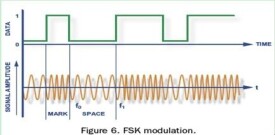PSK
相移鍵控
PSK(相移鍵控):一種用載波相位表示輸入信號信息的調製技術。移相鍵控分為絕對移相和相對移相兩種。以未調載波的相位作為基準的相位調製叫作絕對移相。以二進位調相為例,取碼元為“1”時,調製后載波與未調載波同相;取碼元為“0”時,調製后載波與未調載波反相;“1”和“0”時調製后載波相位差180°。
目錄
來歷:phase shift keying
相關術語:ASK,FSK,QAM,Modulation
定義:移相鍵控方法是通過改變載波信號的相位值來表示數字信號 1,0的。如果用相位的絕對值表示數字信號1,0,則稱為絕對調相。如果用相對偏移值表示數字信號1.0,則成為相對調相。
PSK的一般表達式:si(t)=(2E/T)^1/2*cos[ω0t+φi(t)],0≤t≤T,i=1,2,...,M
其中φi(t)=2πi/M.
若為二進位PSK(BPSK),M=2.
概 述 在某些數據機中用於數據傳輸的調製系統,在最簡單的方式中,二進位調製信號產生0和1。載波相位來表示信號占和空或者二進位1和0。對於有線線路上較高的數據傳輸速率,可能發生4個或8個不同的相移,系統要求在接收機上有精確和穩定的參考相位來分辨所使用的各種相位。利用不同的連續的相移鍵控,這個參考相位被按照相位改變而進行的編碼數據所取代,並且通過將相位與前面的位進行比較來檢測。
相移鍵控(PSK):一種用載波相位表示輸入信號信息的調製技術。移相鍵控分為絕對移相和相對移相兩種。以未調載波的相位作為基準的相位調製叫作絕對移相。以二進位調相為例,取碼元為“1”時,調製后載波與未調載波同相;取碼元為“0”時,調製后載波與未調載波反相;“1”和“0”時調製后載波相位差180°。
根據香農理論,在確定的帶寬裡面,對於給定的信號SNR(信噪比),其傳送的無差錯數據(在有雜訊影響的情況下接受到的正確數據)速率存在著理論上的極限值。
在特定的數據速率下,信號的帶寬和功率大小可以互相轉換(在信號功率增強的情況下信號帶寬縮小后仍能保證有同樣的傳輸速率;增大帶寬而降低功率能達到同樣的效果),PSK就是這一理論的成功應用,理論成功地應用於傳播狀態極端惡劣的短波頻段。
由於頻率、相位調製對雜訊抑制更好,PSK成為當今大多數通訊設備的首選方案。
Phase-shift keying (PSK) is a digital modulation scheme that conveys data by changing,or modulating,the phase of a reference signal (the carrier wave).
Any digital modulation scheme uses a number of distinct signals to represent digital data. In the case of PSK,a finite number of phases are used. Each of these phases is assigned a unique pattern of binary bits. Usually,each phase encodes an equal number of bits. Each pattern of bits forms the symbol that is represented by the particular phase. The demodulator,which is designed specifically for the symbol-set used by the modulator,determines the phase of the received signal and maps it back to the symbol it represents,thus recovering the original data. This requires the receiver to be able to compare the phase of the received signal to a reference signal — such a system is termed coherent.
Alternatively,instead of using the bit patterns to set the phase of the wave,it can instead be used to change it by a specified amount. The demodulator then determines the changes in the phase of the received signal rather than the phase itself. Since this scheme depends on the difference between successive phases,it is termed differential phase-shift keying (DPSK). DPSK can be significantly simpler to implement than ordinary PSK since there is no need for the demodulator to have a copy of the reference signal to determine the exact phase of the received signal (it is a non-coherent scheme). In exchange,it produces more erroneous demodulations. The exact requirements of the particular scenario under consideration determine which scheme is used.
